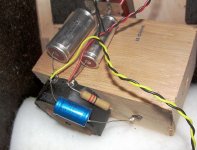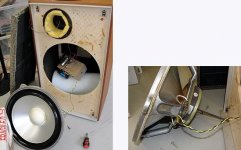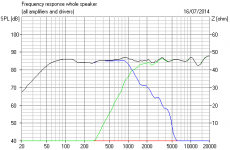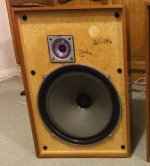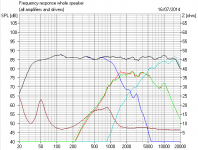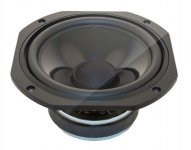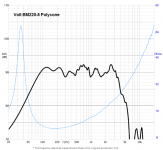Irony, irony. A two way stumpy rectangular box from the 70s with sharp corners driven by solid state amps with LM318s in the audio path is considered 'the sound of the show' by many of the attendees.Just heard a pair of the LS5/8s in Lodgesound's reel to reel tape recorder room at the Hifi wigwam show. I am of course perplexed and troubled (by all that 70s/80s opamp electronics and retro plastic drivers etc) but they did sound good, and some including myself would say they were one of the better sounds at the show…
It simply confirms what I knew all along: hi fi peaked in the 70s and 80s, and is going backwards. Contrary to what someone said earlier, speaker design is just about slapping some reasonably-compatible drivers in a big rectangular box and setting reasonably-appropriate crossover slopes and frequencies, phase correction and time delays - all as easy as rolling off a log with an active setup, and no need to economise with two way: go three. Compared to today's 'high end' travesties it is guaranteed to sound sweet - as yesterday's attendees have found out.
I do, of course bow to your expertise in these matters, but I can't help but think that you are tinkering at the edges between very good and excellent, a distinction which is completely lost on most people. At shows, we hear such horrors that are then written up as utterly marvellous that I think most people would be amazed simply to hear a monkey coffin speaker slapped together following the recipe I outline above!
Interesting reading in this topic! I have heard many conflicting views of LS5/8s over the years, mostly about 'uncontrolled bass' which is improved by using stands and keeping them away from the walls. There are a couple of electrolytic capacitors which, when failing, cause a rising response at low frequencies. These make the 'flappy bass' worse, as expected, until the hum gets unbearable!
Of the BBC speakers designed around that time prefer the LS3/7s actually, though not as loud, and the wide front with handles on the side make them a bit domestic environment unfriendly. I may be a little biased in this matter 'though!
LS5/8s without amplifiers are not too expensive, and would save the effort of finding suitable bass units and all that woodwork.
Of the BBC speakers designed around that time prefer the LS3/7s actually, though not as loud, and the wide front with handles on the side make them a bit domestic environment unfriendly. I may be a little biased in this matter 'though!
LS5/8s without amplifiers are not too expensive, and would save the effort of finding suitable bass units and all that woodwork.
Contrary to what someone said earlier, speaker design is just about slapping some reasonably-compatible drivers in a big rectangular box and setting reasonably-appropriate crossover slopes and frequencies, phase correction and time delays - all as easy as rolling off a log with an active setup, and no need to economise with two way: go three. Compared to today's 'high end' travesties it is guaranteed to sound sweet - as yesterday's attendees have found out.
You can certainly make as nice a sounding speaker as you would want based on parts from the 70's. It can also look totaly mundane in design.
In the end the sound quality is tied to refinement in fine tuning the crossover to perfect the balance. This is down to the skill of the designer ( this hasn't, and won't likely, change in our lifetimes) The BBC was very skilled in refining their designs and had the benefits of live musicians next door to compare to and smart researchers such as Harwood to work out some of the details. They were also designing products with a focus of purpose and with no need to follow fashion or please the market.
David
12" bass plus tweeter is actually a rather good design. It's also quite hard in some respects because of the low crossover required, which makes demands on the tweeter and it has a lowish impedance on 8 ohm drive units. The 1969 LEAK Sandwich was a design of this ilk. It's frequency response is simulated below. Dispersion and phase is actually rather good, which is a surprise. 
The Wharfedale Melton 2 was similar, and had a good sound too. Definitely not garbage!
The Wharfedale Melton 2 was similar, and had a good sound too. Definitely not garbage!
Attachments
To my ears the LS 5/8 completely blew away the very expensive Naim/Neat MF7 system at Scalford.
The rather expensive diy Scanspeak 2-way speakers weren't much good either and proved how getting the crossover right is so incredibly important. With the right crossover those drivers should have produced a much better sound than I heard.
The 12" (Goodmans?) full range drivers with open backs were excellent too. I always thought large full range drivers were supposed to be rubbish because of beaming and breakup but was proved wrong here.
It's surprising what you can learn from going to Scalford and I'd highly recommend it.
The rather expensive diy Scanspeak 2-way speakers weren't much good either and proved how getting the crossover right is so incredibly important. With the right crossover those drivers should have produced a much better sound than I heard.
The 12" (Goodmans?) full range drivers with open backs were excellent too. I always thought large full range drivers were supposed to be rubbish because of beaming and breakup but was proved wrong here.
It's surprising what you can learn from going to Scalford and I'd highly recommend it.
It's a classic school of speaker building! 
12" plus tweeter does tend to blow the tweeter though. The 12" is very loud, and not many HF units or 3" fullrangers can keep up with it. Wharfedale tweeters were notorious for frying.
A better approach is to wire two mids in series for 16 ohms, and add a tweeter to help the top end dispersion above 5kHz.
Which is near to what the very lively late 1970's Wharfedale E70 did. A speaker that many people admire.
Is that a two way improved, or a three way? It IS second order electrical filters.
12" plus tweeter does tend to blow the tweeter though. The 12" is very loud, and not many HF units or 3" fullrangers can keep up with it. Wharfedale tweeters were notorious for frying.
A better approach is to wire two mids in series for 16 ohms, and add a tweeter to help the top end dispersion above 5kHz.
Which is near to what the very lively late 1970's Wharfedale E70 did. A speaker that many people admire.
An externally hosted image should be here but it was not working when we last tested it.
Is that a two way improved, or a three way? It IS second order electrical filters.
Or Cerwin Vega!I never heard a pair but it always looked to me like the British trying to do the JBL thing. Not a pretty sight.
David
An externally hosted image should be here but it was not working when we last tested it.
The Wharfedale Super 8/If you ever see a Wharfedale E70 or E90 on eBay, try to have a listen. This were very brash looking, 94dB/2.83V speakers designed in late 70's for pop. What is not commonly known is that they were also very accurate and good for classical.
This is from my post to a forum about Blind Listening Tests and Golden Pinnae. One of my main contributions to Wharfedale was insistence on proper Blind Listening for development of speakers. **** "Bat Ears" ******** is one of the 2 best ears I have put through (several) Wharfedale Blind Listening tests.
I remember these monsters and everybody though they were a bad joke on Cerwin Vega. I regret I never took a listen.
For sure a high-efficiency 10" driver will provide dynamics that will leave most 6"+1" floorstander far behind.
In the late 70's, HiFi News attempted the 1st mass review of speakers with a crude Blind Listening Panel including 'Bat Ears' ********. The speaker which came top was the Wharfedale E70. This was a very efficient speaker; at 94dB @ 1m / 2.83V, well suited for 'pop'. The editor (John Crabbe I think) said, "we can't publish this" as the other speakers included some famous 'BBC' type designs.
Thing is, if you sim it, it works out better than any other three way I can think of! Power handling is excellent. Even phase and impedance is exceptional. All on a simple crossover. My flatmate had some, and I gotta be honest, they blew the socks off my 3-way BBC monitors.
Attachments
Last edited:
Or Cerwin Vega!
Thing is, if you sim it, it works out better than any other three way I can think of! Power handling is excellent. Even phase and impedance is exceptional. All on a simple crossover. My flatmate had some, and I gotta be honest, they blew the socks off my 3-way BBC monitors.
Who would have known? I guess you can't judge a book by its cover....
Apparently there will soon be a new Derek Hughes-designed passive crossover for the LS5/8 available from Graham Audio.
But that wouldn't be DIY!
As it goes, Graham are doing a good job on an LS5/9 with a smaller Volt 8" polycone and the Audax TW034 tweeter. A lot of equalising needed though.
But I see no reason why you can't use an 8" or 10" or 12" paper bass. It might be a lot simpler filter really. Most of them are quite well behaved.
Attachments
Dear All,
Thank you for your advice and opinions so far. Everything said here (and, often by the same people, in other threads) certainly needs to be considered. I will have to calculate the WAF in to some degree as well.
Yesterday, I had the opportunity to "slam" one of those Audax TWO34 tweeters into a box and nothing could better demonstrate what tvrgeek and others said about loose experiments and advancing technology. Wasn't my idea, my friend Fred wanted to replace a blown 'pink' Wharfedale tweeter (in an old Dovedale 3 box). Cross-over at 5 KHz, 2nd order if I'm not mistaken. The lack of both balance and smoothness was remarkable, to say it politely. At least the hiss from that old tube amplifier was now clearly audible.
So, I realize I better do a lot of homework first, then invest my efforts in something not too deceiving. Maybe a BBC-style speaker, but not necessarily an active one along the lines of the LS5/8 (and I always had my doubts about the somewhat veiled, "behind the curtain" character of the Quad 405, even after refreshing it's circuits).
For now I'm tempted by the Seas offerings (also considering the Seas Mimir as an exercise, my son keeps requesting a reasonable speaker set while his girlfriend insists on a cabinet in the same colour as their walls), but I could also fall for one of Troels Gravesen's open baffles (tribute to Gilbert Briggs -- aah!, again suffering from nostalgia). Definitely low WAF, this one.
It's definitely going to be interesting. Thank you all so far for your valuable thoughts.
Troels is well acquainted with the advantages and shortfalls of modern speaker design. His endorsement of Briggs' Open Baffle cannot be discounted as mere nostalgia. I say have some fun and build a pair of OB using new or old drivers, WAF be damned!
- Status
- This old topic is closed. If you want to reopen this topic, contact a moderator using the "Report Post" button.
- Home
- Loudspeakers
- Multi-Way
- Cloning BBC LS 5/8 monitors -- worthwhile or even possible?
